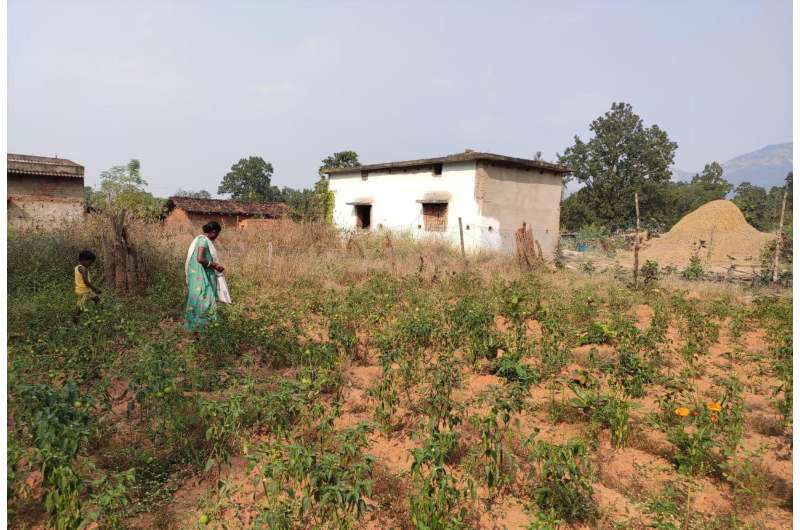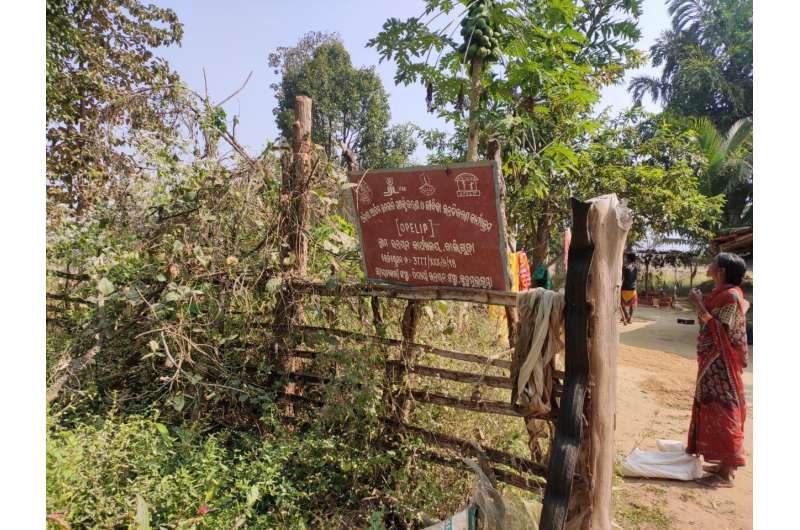Home gardens are key to better lives for vulnerable tribes in India, finds research
by The Alliance of Bioversity International and the International Center for Tropical Agriculture

The forested hills and rolling fields in the state of Odisha are home to some of India’s most vulnerable tribal groups, but a growing number of studies show that small home gardens—producing millet, pulses, fresh fruits and vegetables—could be key in the fight against the food insecurity, malnutrition and poverty found there.
Battle against hunger
In 2020, 828 million people globally went hungry and almost 3.1 billion people could not afford a healthy diet, according to World Health Organization (WHO) statistics.
Despite India now being a middle-income country, it continues to struggle with food security, malnutrition, and rising levels of anemia among women and children.
In recent years, there have been a growing number of studies about how home gardens—which, as the name suggests, are fruits, vegetables, or grains grown at a household scale—might help fight hunger, but there has been limited field evidence of their effects on food security, dietary quality, and incomes.
In a new paper, “Home gardens, household nutrition and income in rural farm households in Odisha, India,” published in the Journal of Agricultural Economics researchers from the Alliance of Bioversity International and CIAT looked at about 1,900 households in tribal communities in the state of Odisha, India and produced solid evidence that home gardens can improve food security, dietary quality, and income in these rural farming communities.

Better food security
Sylvester Ogutu, a researcher for the Alliance of Bioversity International and CIAT and the paper’s lead author, said that having a home garden increased annual home-produced food by nearly 90 percent.
“Our findings also suggest that home gardens can be a poverty-reducing strategy for resource-poor farmers and vulnerable population groups,” Ogutu said, adding that the monthly value of home-produced and consumed food per adult rose by over half, increasing the probability of greater food security among adopters of home gardens.
“Having a home garden also increased monthly per adult equivalent incomes by 37% and reduced the prevalence of poverty by 11.7 percentage points,” he said.
A bright future for home gardens
Jonathan Mockshell, an agricultural economist at the Alliance of Bioversity International and CIAT, study lead, and a co-author of the paper, said that programs aimed at teaching vulnerable population groups how to start or improve home gardens started in Odisha in 2017 and are ramping up, with three quarters of the home garden interventions completed between 2020 and 2021.

“Home gardens can also complement government programs, such as the National Nutrition Mission, to improve nutrition and also contribute toward achievement of the Sustainable Development Goals, especially those related to poverty, zero hunger, and good health and well-being,” Mockshell said.
“Promotion of home gardens in India can help curb widespread malnutrition problems, such as anemia in women, by improving the quality of diets that are typically less diverse, dominated by cereals, and/or characterized by low intakes of fruits and vegetables,” James Garrett, a co-author, said.
An Indian government program aims to reach over 27,300 beneficiaries with home garden interventions to help increase their production and consumption of highly nutritious home-produced foods, and ultimately improve their food and nutrition security by improving the quality of their diet.
This latest paper is part of a wider push at the Alliance of Bioversity International and CIAT, and the One CGIAR Initiative on National Policies and Strategies to link research evidence on the benefits of home gardens to policy making to contribute to transitioning to resilient food systems.
More information:
Sylvester O. Ogutu et al, Home gardens, household nutrition and income in rural farm households in Odisha, India, Journal of Agricultural Economics (2023). DOI: 10.1111/1477-9552.12525
Provided by
The Alliance of Bioversity International and the International Center for Tropical Agriculture
Citation:
Home gardens are key to better lives for vulnerable tribes in India, finds research (2023, March 27)
retrieved 27 March 2023
from https://phys.org/news/2023-03-home-gardens-key-vulnerable-tribes.html
This document is subject to copyright. Apart from any fair dealing for the purpose of private study or research, no
part may be reproduced without the written permission. The content is provided for information purposes only.
For all the latest Science News Click Here
For the latest news and updates, follow us on Google News.

